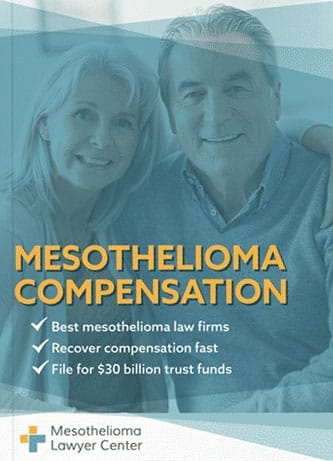W.R. Grace made asbestos products and mined and distributed vermiculite contaminated with asbestos. It was responsible for polluting the small town of Libby, Montana, with asbestos and has been held accountable through lawsuits and fines. W.R. Grace currently compensates claimants through two asbestos trust funds.
If you suffer from mesothelioma, asbestos-related lung cancer, or asbestosis, you may be eligible for a large amount of compensation. Currently, there is over $30 billion in asbestos trust funds set up for those who have been diagnosed with an asbestos-related illness. Fill out our form to receive our free Financial Compensation Packet. Our packet is loaded with information on experienced mesothelioma attorneys in your area, how to file a claim for asbestos trust funds, how to get paid in 90 days, and more.


FREE Financial Compensation Packet
- Info on law firms that will recover your HIGHEST COMPENSATION
- Learn how to get paid in 90 days
- File for your share of $30 billion in trust funds

Did W.R. Grace Use Asbestos?
W.R. Grace used asbestos in its products and indirectly in products made by subsidiary companies. W.R. Grace also operated a vermiculite mine in Montana that was contaminated with asbestos. Most of its products made with asbestos were insulation and other construction materials.
W.R. Grace History
- W.R. Grace & Co. was founded in 1854 by William Russell Grace in Peru. Grace’s brother joined the company a few years later, and together, they moved to New York City and changed the business name to Grace Brothers & Co.
- In the beginning, the company focused on machinery and fertilizer products until its official incorporation in 1895. W.R. Grace evolved from a business focused on agricultural products to a chemical and transportation company.
- As the company expanded, W.R. Grace entered numerous industries, including banking and passenger ships. By the 1970s, W.R. Grace’s chemical sales made up more than half of the company’s yearly revenues. It acquired Davison Chemical Company, Dewey & Almy Chemical Company, and others.
- In 1963, W.R. Grace acquired Zonolite and took over the operations of vermiculite mines in Libby, Montana. The vermiculite mines were contaminated with asbestos. Not only were workers placed at risk, but Libby residents were exposed and developed asbestos diseases at higher-than-average rates.
- Also affected by the mine’s asbestos-contaminated vermiculite were workers in processing plants. The company distributed vermiculite throughout the country to plants where workers made Zonolite insulation.
- Court documents indicate that W.R. Grace knew about the hazards of asbestos exposure from the mines. Yet, the company chose not to warn anyone and continued to mine.
- W.R. Grace eventually faced hundreds of thousands of lawsuits over the mines in Libby and its asbestos products. It filed for bankruptcy in 2001, reorganized, and opened asbestos trusts to resolve claims.
- In 2023, W.R. Grace settled with the Montana Department of Environmental Quality over the cleanup of the site in Libby, Montana.
W.R. Grace Asbestos Products
W.R. Grace began using asbestos as early as the 1930s. At the time, and until the 1970s, asbestos was used in many industries to insulate and strengthen materials. Most of W.R. Grace’s asbestos products were used in the construction industry. Some of these products include:
- Ez Tex
- Monokote Cement
- Monokote Fireproofing
- Perltex Spray Surfacer
- Perltex Super-40 Perlite
- Zono-Coustic
- Zonolite Acoustical Plastic/Plaster
- Zonolite Cement
- Zonolite Fireproofing
- Zonolite Plaster
- Zonolite Spra-Tex
- Z-Tex
- Econo-White
- Insulating Cement
Who Was Affected by W.R. Grace Asbestos?
W.R. Grace’s asbestos use affected people all over the U.S. From its own employees to workers in the construction industry and residents living near Zonolite facilities, hundreds of thousands of people came into contact with asbestos because of W.R. Grace.
W.R. Grace Employees
First in line to be exposed to asbestos from W.R. Grace were the company’s employees. Workers in manufacturing plants risked exposure when handling and using asbestos to make construction products.
Also at risk were miners and other workers at the vermiculite mines in Libby. Anyone working directly with or near people working with asbestos has a high risk of exposure. By handling asbestos and asbestos materials, they release fibers into the air, where they can be inhaled.
Vermiculite Plant Workers
Zonolite workers who processed vermiculite to make insulation faced the same risks. W.R. Grace shipped asbestos-contaminated vermiculite to processing plants all over the country. These workers handled the contaminated mineral for years without being told of the risks and dangers.
Workers in Other Industries
W.R. Grace and Zonolite asbestos products were distributed to other companies for use in other industries, especially construction. Some of the many workers at risk of asbestos exposure from working with or near W.R. Grace asbestos products include:
- All construction workers
- Insulators
- Carpenters
- Plumbers
- Electricians
- Roofers
- Painters
- HVAC workers
- Laborers
- Demolition workers
- Maintenance, repair, and renovation workers
Residents in Libby and Near Vermiculite Plants
The residents in and around Libby, Montana, were exposed to asbestos while the mine operated. According to studies, more than 400 residents in the area died as a result of asbestos exposure. This is a very high rate for a small population of just a few thousand.
Residents of the areas around the many Zonolite vermiculite plants also faced exposure risks.
W.R. Grace Asbestos Lawsuits
W.R. Grace has faced hundreds of thousands of lawsuits over asbestos exposure from its products, vermiculite plants, and the Libby mines. Lawsuits have come from individuals, groups, and government agencies.
In 2005, the U.S. Department of Justice started a criminal proceeding against the company. Per court documentation, at least seven W.R. Grace executives understood the risks of asbestos and knowingly continued putting people in harm’s way.
These executives knew about the dangers as early as the 1970s. W.R. Grace didn’t shut down the contaminated mine until 1990.
Although the company was eventually acquitted of the criminal charges in 2009, W.R. Grace wasn’t let off the hook for the many lives ruined due to asbestos exposure. The government ordered the company to pay fines and cleanup fees. This included $250 million paid to the U.S. Environmental Protection Agency (EPA) for cleanup efforts at the Superfund site.
Montana’s government also sued W.R. Grace for Libby contamination. They settled after years of negotiations. W.R. Grace agreed to pay the state $18.5 million.
Although the company’s asbestos trust now resolves claims, W.R. Grace also faced lawsuits from individuals. A jury in New York awarded Marvin Penn $16.25 million in 2008 for his mesothelioma diagnosis. Penn was exposed to asbestos in products made by W.R. Grace and other companies. The jury found W.R. Grace to be 40% liable.
Facing some of the most significant asbestos-related lawsuits in the United States, W.R. Grace filed for Chapter 11 bankruptcy protection in 2001.
Bankruptcy and the W.R. Grace Asbestos Trust
W.R. Grace filed for voluntary bankruptcy on April 2, 2001. The company planned to resolve asbestos claims and reorganize under Chapter 11 protection.
At the time of the bankruptcy filing, W.R. Grace faced over 129,000 asbestos lawsuits. About 120 of these were related to the Libby mines.
W.R. Grace settled with the Official Committee of Asbestos Personal Injury Claimants and others in 2008. A plan to create two trusts and emerge from bankruptcy was approved and confirmed by the Bankruptcy Court in 2011.
All appeals of the bankruptcy plan were resolved by 2013, and the Joint Plan of Reorganization became effective on February 3, 2014.
W.R. Grace opened two trusts to compensate asbestos claimants:
- The Zonolite Attic Insulation Trust was established to reimburse homeowners with Zonolite attic insulation. The funds are to help people remove and replace this asbestos insulation.
- The WRG Asbestos Personal Injury Trust was established to address all asbestos claims related to personal injuries, including claims related to the Libby mines.
The WRG Asbestos PI Trust recognizes a total of eight diseases, including the most serious:
Part of W.R. Grace’s accepted agreement was to allocate $1.8 billion to compensate asbestos victims. Before filing for bankruptcy, the company tried to hide billions of dollars in subsidiaries. The Department of Justice called the action fraudulent and required the company to move $1 billion back.
The WRG PI Asbestos Trust currently has a payment percentage of 31.7%. This is higher than most asbestos trusts.
The W.R. Grace Libby Superfund Site
The EPA listed the Libby, Montana, site as a Superfund and has since been participating in cleanup efforts. The EPA and other agencies have been working on the site since 2000, but it is not clear of asbestos.
The efforts have made a difference. Testing indicates that levels of asbestos fibers in the air are 100,000 times lower than when the mine last operated.
In addition to cleaning up the area, the EPA has helped bring in healthcare for residents. The EPA declared a Public Health Emergency, which made Libby residents eligible for federal health aid.
W.R. Grace contributed nearly $300 million to the cleanup of Libby. It has also provided $54 million for other Superfund sites across the country.
W.R. Grace Today
In 2014, shortly after it emerged from bankruptcy, W.R. Grace built a 90,000-square-foot headquarters in Columbia, Maryland, which sits on 160 acres.
The company is still in the international chemicals, technology, and materials field, but it no longer uses asbestos in any of its products. Now known as just Grace, it also operates a technical services center, as well as a manufacturing plant in Baltimore.
What to Do if You Were Exposed to W.R. Grace Asbestos
Contact an asbestos law firm if you think you can trace your asbestos illness to W.R. Grace mines, vermiculite, or other products, like Zonolite insulation.
A mesothelioma lawyer can help you determine if you are eligible for a claim and help you file. They can also review your work history and find any other asbestos companies that are liable for your illness.
Additional Resources and Information
If you’ve been injured by mesothelioma, asbestosis, or asbestos-related cancer, keep in mind that there is a good chance that you’ll qualify for considerable compensation for pain, suffering, medical costs, and much more. Remember to fill out our form for your free Financial Compensation Packet, with information on asbestos and mesothelioma lawyers in your area.

Paul Danziger
Reviewer and EditorPaul Danziger grew up in Houston, Texas and earned a law degree from Northwestern University School of Law in Chicago. For over 25 years years he has focused on representing mesothelioma cancer victims and others hurt by asbestos exposure. Paul and his law firm have represented thousands of people diagnosed with mesothelioma, asbestosis, and lung cancer, recovering significant compensation for injured clients. Every client is extremely important to Paul and he will take every call from clients who want to speak with him. Paul and his law firm handle mesothelioma cases throughout the United States.
References
- Grace. (n.d.). About Grace.
Retrieved from: https://grace.com/about-grace/ - McCumber, D. (2018). As Libby Asbestos Cleanup Gets Done, the Dying Continues. Great Falls Tribune.
Retrieved from: https://www.greatfallstribune.com/story/news/2018/10/06/libby-asbestos-cleanup-gets-done-dying-continues/1553592002/ - Naik, S.L., Lewin, M., Young, R., Dearwent, S.M., and Lee, R. (2017, March). Mortality from Asbestos-Associated Disease in Libby, Montana 1979-2011. J. Expo. Sci. Environ. Epidemiol. 27(2), 207-13.
Retrieved from: https://www.ncbi.nlm.nih.gov/pmc/articles/PMC5318660/ - Grace. (n.d.). Asbestos Trusts.
Retrieved from: https://grace.com/about-grace/our-history/asbestos-trusts/ - WRG Asbestos PI Trust. (n.d.). WRG Asbestos PI Trust.
Retrieved from: http://www.wrgraceasbestostrust.com/ - Huslin, A. (2008, April 8). W.R. Grace to Settle Asbestos Claims For $1.8 Billion, Start New Chapter. The Washington Post.
Retrieved from: https://www.washingtonpost.com/wp-dyn/content/article/2008/04/07/AR2008040702384.html - Associated Press. (2023, January 10). W.R. Grace Offers $18.5M to Settle Montana Asbestos Claims.
Retrieved from: https://apnews.com/article/health-business-montana-public-greg-gianforte-3533fb7fb90e366ec0e8c99868ed0545
